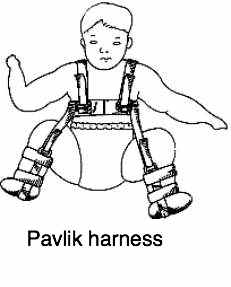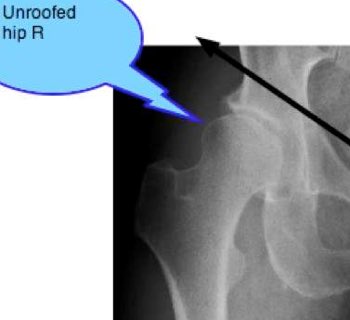- Home
- Hip arthritis
- Pavlik harness
Pavlik Harness
Pavlik harness is used constantly in the first month and half of your baby's life after which she or he will be weaned off the device over the next few months.
Does your baby's hip give a deep sounding thunk when you are changing his or her diaper? It's vital that you get your infant to a orthopedist specialized in childhood conditions, or your chiropractor if they have experience in treating children.

Developmental Hip Dysplasia is
a condition more frequent in a breech or transverse presentation in
utero; consequently a shallow socket for the femoral head is formed.
This allows the head to subluxate or dislocate, firstly in the newborn
but continuing into adult life.
The key tests performed by your chiropractor are the Ortholani, Galeazzi and Barlow manoeuvres. You may yourself notice abnormal skin folds in the groin and that resounding thunk, rather than a click, in the hip when you change your baby's diaper.
DDH in its severe form will be immediately detected by the paediatrician, but mild conditions can slip through undetected. If present, it is essential that your child wears a Pavlik Harness which keeps the hips firmly set in the socket. This allows the developing acetabulum to grow deep enough to support the ball. It can only be used in the first few months of the infant's life to be effective.
This page was last updated by Dr Barrie Lewis on 19th December, 2021.
Pavlik Harness
In our chiropractic clinics we see a significant number of patients, young and old, with DDH that was not detected at birth. A Pavlik harness would have prevented a lifetime of pain.
The pain develops in the groin, and often radiates either down towards the knee, or upwards to the upper lumbar spine.
The leg may actually collapse under your weight, and I've recently be treating a lad of 10 who had pain so severe that he was in a wheelchair for a week. Luckily he's back playing football, though that is being carefully assessed. Sometimes your sporting routine may have to be changed to accommodate the changes in the hip.
It is a condition that can, in the adult, be well managed with chiropractic but really the solution is early diagnosis, and use of the Pavlik harness for your baby. It's a simple device that will causes your baby no discomfort; far better than a lifetime of misery.

Hip arthritis
The above radiograph is of a 52-year old man, a new patient this week in the clinic. The hip arthritis is only just beginning, but is already very achy and stiff. Pulling on socks is difficult, walking painful and internal rotation limited. The partially unroofed hip and sloping acetabulum are characteristic of dysplasia; he does not know whether he was put in a Pavlik harness as a baby or not.
1 in 10 total hip replacements are caused by dysplasia, and it is the most common cause of arthritis in the joint before 50 years.
In short hip arthritis is in the making. We'll see how he progresses over the next months with chiropractic.
Update: Mr S has responded very well. It's a year down the line and he consults me once a month. The range of motion has improved greatly, he can dress normally, but walking more than a few kilometres remains painful. Neither I, nor anyone can cure him. He may still have to have a total hip replacement, but rather at 65 than 53. They are only guaranteed to last about 15 years.
The reduced movement limits the flow of capsular fluid in the joint resulting in poor nutrition of the hyaline cartilage; untreated it will rapidly degenerate. Chiropractic aims to increase the movement in the joint.
The most part of the treatment is the gentle mobilisation of the joint done every day by the patient.
Hyaline cartilage
The hip and socket are lined with hyaline cartilage; it's a super smooth substance that has no blood supply of its own; it's nutrition comes from the fluid in the joint; the constant subluxation of the ball tends to wear it out prematurely if the hip dysplasia was not discovered and a Pavlik harness provided.
In DDH there is decreased contact between the two surfaces which have to bear more weight. Coupled with the constant subluxation that occurs, the hyaline cartilage wears away leaving bare bone exposed much more quickly that in the normal hip.
If there is also a poor diet, obesity and smoking, then the hip is very likely to degenerate.
About four births per thousand have Developmental Hip Dysplasia. The incidence is five times higher (around 1/50) in breech births. The signs for the observant mother are a deep sounding "thunk" as the hip slips in and out of the socket, and there may be changes in the skin folds in the groin.
If there is doubt, and ultrasound 'echo' scan is used. This has the advantage of no ionising radiation such as X-rays and the examiner can see precisely what happens when the "thunk" occurs. Does the hip subluxate or dislocate as it is moved into different specific positions?
Missed, the young toddler will walk with an unusual waddling gait if the dysplasia is in both hips, with a greatly increased lordosis in the lumbar spine. This sets your baby up for not only hip and groin pain, but back pain in the future. A technically difficult operation is on the cards, when the hip has to be completely dislocated. The trick is not to be neurotic but, if you notice something unusual, the sooner you do something the better.
Treated early the Pavlik harness means that the hip, kept firmly in the socket for six weeks, carves a normal deep socket. Missed and neglected, your baby will likely have a shallow socket, an "unroofed" hip, and the prospect of much pain and one or more total hip relacements in his or her future. Prevention is the key; a Pavlik harness.
The young adult presents with groin pain, and often pain in upper lumbar spine and sacroiliac pain. The hip may "give." It may be one or both hips. Running a finger up the inner thigh causes severe pain. Big time, the muscles of the groin, and the capsule are extremely tender on palpation. Ranges of motion of the hip are clearly increased.
As the years progress gradually the range of motion decreases as the labrum wears and subtle signs of hip degeneration develop. Ultimately severe arthritis develops with the first, possibly of several, total hip replacements.
For another perspective from the hip dysplasia institute read more about the Pavlik harness[1].
The Chiropractic contribution
With increasing numbers of colicky babies being examined and treated by Chiropractors, it is essential that they too are on the lookout for Hip Dysplasia. Even the best paediatrician can miss a mild case.
I now routinely treat young adults, middle aged folk and the older person with DDH.
They present invariably with groin and often low back pain. This back pain may be at the thoraco lumbar junction, mediated via the Femoral nerve and Psoas muscle, and in the sacroiliac joint. Obviously the sooner one detects the disease and starts treatment the better.
The response to chiropractic? Generally excellent in the young and middle aged patient. Once the stiffness and arthritis starts it becomes increasingly difficult.
Chiropractic Help
Frankly I have never treated a baby with DDH. I think this is something in which our orthopaedic colleagues are experienced and excel. Perhaps there are DCs providing chiropractic help and prescribing a Pavlik harness, and I see no reason why not, but currently I personally leave this to our medical colleagues.
It's the young and middle aged adult where chiropractic comes into its own. Treatment can be summarised as:
Direction.
The patient with DDH has to accept that long distance walking and running is not for them. A 5-10 kilometre hike? No problem. The "Four day 200km hike in Nijmegen" that the Dutch are currently feverishly preparing for is sheer madness for the patient with DDH.
Gentle mobilisation of the hip, if there is limited range of motion.
If present, management of a short leg using a heel lift.
Careful regular examination of the sacroiliac joint which tends to subluxate.
Hypermobility
It's important to make a distinction between "hypermobility", and hip dysplasia; they present in very similar ways. Both may cause groin and upper leg pain, both have increased range of motion. Both may in fact progress to hip arthritis, but the hip dysplasia is far more serious.
An ultrasound scan in the child, and an X-ray in the adult are vital. Miss hip dysplasia in your child and he or she will have a lifetime of serious hip trouble. He will be disabled.
Useful links
A simple set of daily exercises to maintain the range of motion and strengthen the muscles associated with the hip.
Correction of any sacroiliac and lumbar subluxations.
Active release technique for the muscles and capsule in the groin. This can be extremely painful. The pain is short-lived, perhaps thirty seconds, a hot feeling in the leg for a day, and then astonishing progress.
- The Wheaton-Pavlik harness: A guide for parents
- Nutritional support: chicken bones bouillon
- Sacroiliac joint anatomy
- Pubic bone pain
- Home
- Hip arthritis
- Pavlik harness
Did you find this page useful? Then perhaps forward it to a suffering friend. Better still, Tweet or Face Book it.
